-

新人教版高中英语选修4Unit 1 Science Fiction教案
本活动旨在落实课时教学目标2。 1.Think, discuss and share. Students form groups of 4, discuss about the given ending make comments. Q1: Do you like the ending? Q2: Was it a logical ending? Why so or why not? [设计意图]通过引导学生思考、讨论、评价,比较个人、同伴所预测的结局和听力文本所给定的结局的异同点,深化对文本的认知,发展学生的评判性思维能力。 Activity 4: Exploring Asimov’s three laws of robotics and the purpose of the writing 本活动旨在落实课时教学目标3。 1. Get to know Isaac Asimov’s three laws of robotics. The teacher shares Isaac Asimov’s three laws of robotics. The three laws state that: ①A robot may not injure a human being or, through inaction, allow a human being to come to harm. ②A robot must obey any orders given to it by human beings, except where such orders would conflict with the First Law. ③A robot must protect its own existence as long as such protection does not conflict with the First or Second Law. Q: How does Tony’s story relate to the laws? 2. Figure out Isaac Asimov’s purpose of writing Satisfaction Guaranteed. The students express their opinions about the author’s writing purpose. Q: Why did Isaac Asimov write such a story? S: To explore the relationship between robots and humans. [设计意图]通过了解艾萨克·阿西莫夫所制定的机器人三大定律,加深学生对文本的理解,深入探究文本的主题意义。推理作者的写作目的,联系生活实际,思考人类与机器人的关系。
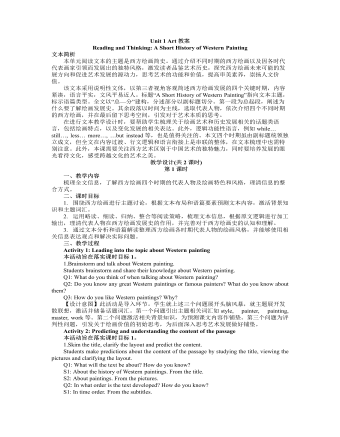
新人教版高中英语选修3Unit 1 Art教案
[2] An important breakthrough…was… [3] Another innovation was … [4] the emphasis increasingly shifted from…to… [5] New ideas and values gradually replaced… [6] While his paintings still had religious themes… … T: All these expressions serve to show how Western painting has developed. Some of them share similar structure but with varied use of words, which makes the text vivid and more readable. 【设计意图】主题类语言整理有助于学生类化语言应用,提高语言输出的丰富性。处理完文本内容信息后,进入语篇信息处理,进行主题相关的词块归类。引导学生快速阅读,寻找表达相同主题(发展或者艺术)的词和短语,再根据词性、用法和结构进行归类,储备主题相关词汇,丰富语言储备,提升语言素养。 Assignment: Go online to gather more information about Chinese painting and write a short history of it. 【设计意图】结合所学,迁移运用,根据实际语境,进行模仿性运用。在此过程中,学生尝试借鉴已学的语言、内容、语篇结构和写作手法来建构新文本,实现语篇输出,同时关注中西艺术文化的差别,加深对优秀文化的认同,培养文化意识。
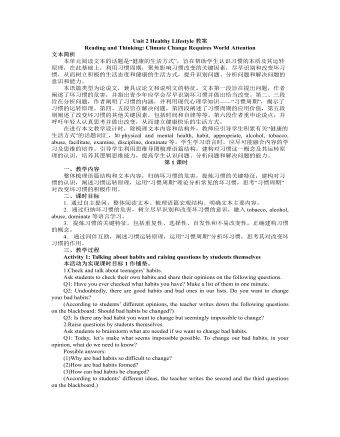
新人教版高中英语选修3Unit 2 Healthy Lifestyle教案
Activity 4: Figuring out the structure and the writing purpose 本活动为实现课时目标2。 1.Read Paragraph 6 and think about its main idea and the writer’s writing purpose. Q1: If you were the author, how would you end your article? “For young people, there is plenty of time to change bad habits. However, there is no “magic pill” or delete button that will help you; you have to think about your bad habits and decide on some changes. You have the power to build a happy and healthy life full of good habits!” Q2: What is Paragraph 6 mainly about? (Possible answer: to appeal to young people including teenagers to change bad habits and live a happy and healthy life.) 2.Think about the writer’s writing purpose and share opinions. Q1: What is the writing purpose? Work in pairs and figure it out. (Possible answer: On the one hand, the passage is written to help teenagers change their bad habits and live a healthy lifestyle. On the other hand, it provides us with a scientific way to identify and analyse our problems objectively, thus strengthening our resolve to tackle the seemingly common yet tough problems in our lives.) 【设计意图】 步骤1旨在预测和验证文章最后一段主要内容,梳理完整的语篇结构,步骤2旨在思考和讨论作者的写作目的。教师也可根据学生课堂反应情况融入对语篇人称多次转换的思考。

新人教版高中英语选修3Unit 4 Adversity And Courage教案
本活动旨在落实课时目标3。 The Student Union is looking for three students for a 3-week voluntary program in Guizhou province. The volunteers have got to be high school students, with a persevering personality and experiences in overcoming adversity. The volunteers need to stay, eat and teach with 20 pupils in a small school up on the hill of a village. There are no facilities but desks and a blackboard in the school. And there is no take-away food to be bought anywhere; the only way to feed yourself is to cook. You’re interested in applying. Write your application letter introducing what adversity you have ever overcome and how persevering you are as well as what you want to do when at work. Dear Student Union,【设计意图】此任务旨在迁移一、二课时所学,解决实际问题。学生对比自己经历过的挑战或挫折,写信给学生会申请前往贵州担任短期支教教师,把个人以前是怎么战胜挫折的经过书写出来。结合所学,迁移创新,分析解决自身实际问题,在真实情境中学生通过仿写进行主题语言的精确输出。完成任务的过程中,能较多地使用已学语言、内容、结构和写作手法来描述自己面对挫折的处理方式、态度和应有的品质,近一步激发学生树立正确的价值观,学会逆境出人才,坚忍不拔,从容不迫,又做到谦让、分享和合作。课后学生修正习作,再次提交。
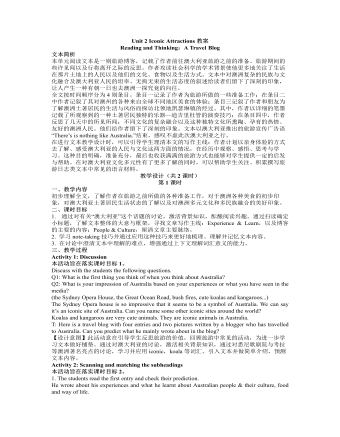
新人教版高中英语选修4Unit 2 Iconic Attractions教案
帮助学生通过讨论与对主题的提升,反思自己的旅游方式,以便做出更优化的安排,在今后的旅程中有更多的收益。 Activity 2: Further discussion of the 6 elements above and supplement of more background knowledge 本活动为实现课时教学目标2。 1.Target Q: The writer’s clear target of traveling, meeting the people and experiencing the culture, is closely related to his major in social studies. Then what is social studies? Social studies is a part of a school or college curriculum concerned with the study of social relationships and the functioning of society and usually made up of courses in history, government, economics, civics, sociology, geography, and anthropology. (Dictionary by Merriam-Webster) Reflection: When you go out to travel, what targets do you usually have in mind? 2.Research Q: Suppose you are traveling to Hangzhou during the school holidays, how will you do research on the city? (surf the internet, read books or travel brochures, consult friends, ...) What information will you be interested to know? (location, iconic sites, local cuisines, interesting customs, shopping malls ...) 3.Abandonment To make the most of time, we have to learn to abandon so that we can accomplish our plan. What will you be interested in doing if you go to Hangzhou if you have a week’s time? What if you only have 2 days? 4~5. Venturing & Experiencing Q: What did he venture to do during the trip? What new experiences did he have? In Sydney: attend his first open-air barbecue, enjoy many different but yummy meals In Catherine: observe the life and customs of the aborigines appreciate their music & try the musical instruments: the didgeridoo
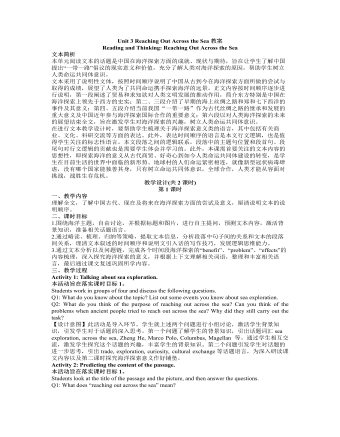
新人教版高中英语选修4Unit 3 Reaching Out Across the Sea教案
本活动旨在落实课时目标3。 Think about the following questions and talk about your own attitude in pairs.Q1: As for this topic,what impresses you the most in the passage?Q2: What do you think of the future of China’s further exploration in sea? Are you in favor of the further exploration?Why or why not? 【设计意图】该活动是一个完全开放性的活动,每个学生都会有不同的答案。运用迁移所学,自由口头表达自己对海洋探索的态度。对于中国海洋探索的未来,每个人的想法是不一样的,有乐观,有担忧,有认为值得投入,也有认为不值得付出太大代价,这里给学生自由表达的空间只要学会有支撑自己观点的事实就可以了,进一步培养学生批判性思维和正确的价值观。 Assignment: 此任务旨在迁移一、二课时所学,培养学生辩证分析问题的能力。 Write about your idea of the future of China’s sea exploration. And add your attitude towards the effort China have made in sea exploration. You’re expected to use the language and the writing technique learnt in the passage.
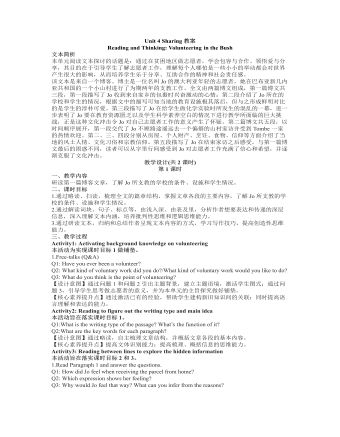
新人教版高中英语选修4Unit 4 Sharing教案
【核心素养提升点】学会将抽象信息进行可视化表达,提高信息处理能力和分析、推理等高阶思维品质;在跨文化交际中学会以国际视野接受和包容不同的文化。 5.Read Paragraph 2, draw a mind map and answer the questions. Q1:What did Jo learn about Tombe’s life? Q2:What kind of life do the natives lead? Read paragraph 2-5 and draw a mind-map. (Focus on accommodation, possession, diet and belief) 【设计意图】引导学生利用思维导图和问题链等形式来厘清当地人的生活方式,更好地处理和归纳信息 【核心素养提升点】提高信息处理能力、分析和归纳能力,包容异国文化、扩展国际视野。 6.Read Paragraph 3 and answer the questions. Q1:What was Jo’s feeling upon arriving her own home? Q2:Why would she feel that way? Q3:Do you think “It was such a privilege to have spent a day with Tombe’s family”? 【设计意图】通过提问,让学生理解Jo的苦并快乐的心情,并通过对“It was such a privilege to have spent a day with Tombe’s family”这句话的理解,体验志愿者生活的伟大。 【核心素养提升点】学会对信息的综合和归纳,从而理解作者所表达的观点。 Activity4: Summarize the change of Jo's feelings
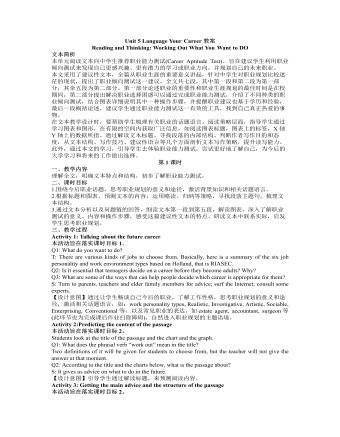
新人教版高中英语选修4Unit 5 Language Your Career教案
本单元阅读文本向中学生推荐职业能力测试(Career Aptitude Test),旨在建议学生利用职业倾向测试来发现自己更感兴趣、更有潜力的学习或职业方向,并规划自己的未来职业。 本文采用了建议性文本,全篇从职业生涯的重要意义讲起,针对中学生对职业规划比较迷茫的现状,提出了职业倾向测试这一建议。全文共七段,其中第一段和第二段为第一部分,其余五段为第二部分。第一部分论述职业的重要性和职业生涯规划的最佳时间是在校期间,第二部分提出解决职业选择困惑可以通过完成职业能力测试,介绍了不同种类的职业倾向测试,结合图表详细说明其中一种操作步骤,并提醒职业建议也基于学历和经验,最后一段概括论述,建议学生通过职业能力测试这一有效的工具,找到自己真正热爱的事物。 在文本教学设计时,要帮助学生梳理有关职业的话题语言。阅读策略层面,指导学生通过学习图表和图形,在有限的空间内获取广泛信息,如阅读图表标题,图表上的标签,X轴Y轴上的数据所指。
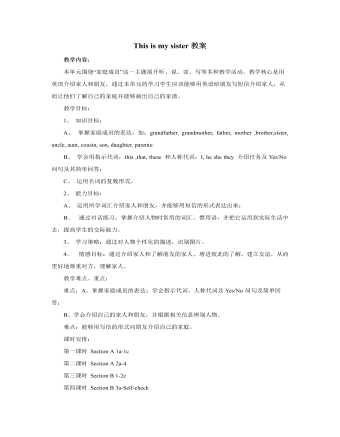
人教版新目标初中英语七年级上册This is my sister教案
(Play the recording twice again.) (Check the answer.) ③Pairwork. Draw your own picture and talk about it. T: We find out the picture of Lin Hai’s family. Can you draw a picture of your family? SS: … T: OK. When you finish drawing, tell your partner about your picture. You can use “This is …” and “ These are …” to talk about. Then report it to the class. (Students work.) (Check students’ work. Ask two or three students to report.) Step Three: Task. Talk about the family tree. T: Look at the family tree. I think it’s a big family. You can do it in groups of four or three. You can do it in pairs or only by yourself. Then report it to the class. (Students work. Teacher walks around in the classroom and helps the students.) T: Stop here. Let’s check it out. (Choose students to do it.) S1: Look at my family tree. This is my… This is my … They have two … This is my … This is my …This is my …This is my. My parents have two children. This is…This is my …My uncle and my aunt have a son. He is my … (Ask two more students to do it.) Homework. Write a passage about your family.
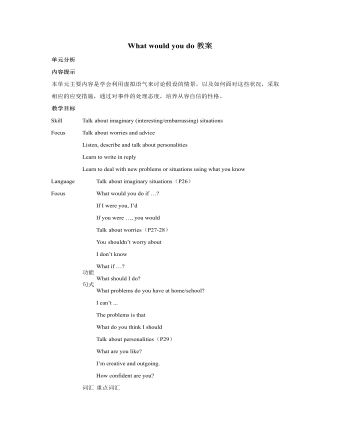
人教版新目标初中英语九年级上册What would you do教案
本课采用任务型教学法,用What would you do if you had a million dollars?这个问句,引出谈论假想情况的话题。 采用提问、启发和归纳的教法,让学生易于接受教材内容,培养学生的语言运用能力。 四、 教学过程设计 Step Ⅰ. Greet the whole class as usual. Step Ⅱ. Warming-up T: Do you have ten Yuan in your pocket? S1: No, I don’t. T: (Take out ten Yuan and give it to the student) OK, never mind. What would you do if it was yours? What would you do if you had ten Yuan? S1: I would buy snacks. T: OK, thank you. Sit down, please. (To the whole class) Just now, it was only ten Yuan. What about 100 Yuan? What would you doif you had 100 Yuan? S2: I’d buy a beautiful jacket. T: Thank you. (To the whole class) Now suppose you had a million dollars, what would you do? We know thatone dollar nearly equals eight Yuan, so that’s a large sum of money. Think it over carefully and tellme your ideas. What would you do if you had a million dollars? S3: I’d buy a big house. S4: I’d buy a sports car. S5: I’d put it in the bank. T: OK, stop here. Please look at the blackboard and guess what would I do if I had a million
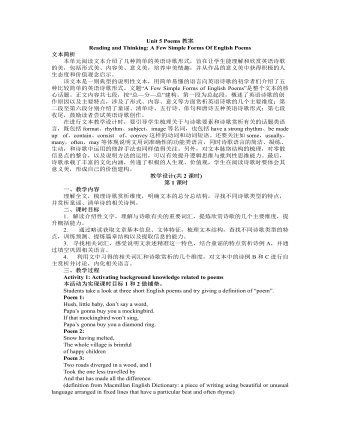
新人教版高中英语选修3Unit 5 Poems教案
本单元阅读文本介绍了几种简单的英语诗歌形式,旨在让学生能理解和欣赏英语诗歌的美,包括形式美、内容美、意义美,培养审美情趣,并从作品的意义美中获得积极的人生态度和价值观念启示。 该文本是一则典型的说明性文本,用简单易懂的语言向英语诗歌的初学者们介绍了五种比较简单的英语诗歌形式。文题“A Few Simple Forms of English Poems”是整个文本的核心话题。正文内容共七段,按“总—分—总”建构。第一段为总起段,概述了英语诗歌的创作原因以及主要特点,涉及了形式、内容、意义等方面赏析英语诗歌的几个主要维度;第二段至第六段分别介绍了童谣、清单诗、五行诗、俳句和唐诗五种英语诗歌形式;第七段收尾,鼓励读者尝试英语诗歌创作。 在进行文本教学设计时,要引导学生梳理关于与诗歌要素和诗歌赏析有关的话题类语言,既包括format、rhythm、subject、image等名词,也包括have a strong rhythm、be made up of、contain、consist of、convey这样的动词和动词短语。

部编版语文八年级下册《小石潭记》教案
【品读课文,把握情感】1.小石潭到底有哪些乐趣呢?(找出“乐”的句子)(1)闻水声,如鸣珮环,心乐之。(2)似与游者相乐。2.深入探究,走近柳宗元。 “一切景语皆情语”,面对如此优美的景色,作者的心情却是“悄怆幽邃”。(播放一首古筝乐曲)这首古筝曲能为课文朗诵配乐吗?你能结合写作背景,说说你的理解吗?作者是被贬官到永州,不幸的遭遇令他感伤,本来想寄情于山水,遣散心中的郁闷,小石潭的美景使他惊叹不已,流连其中,得到了不少乐趣,暂时忘记了心中的痛苦,可是小石潭风景虽美却过于幽静冷清,游玩的时间一长,寒气透骨,难免触景生情,不由得忆起了自己的坎坷命运,忧郁、悲凉的心情自然地流露出来。3.柳宗元怀才不遇的悲凉郁闷,透过文字显现出来了。那么还有哪些中国文人用文字来书写心中壮志难酬的情感?
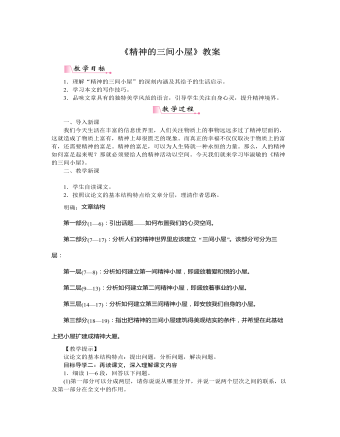
部编版语文九年级上册《精神的三间小屋》教案
(4)写第三间小屋时作者为什么说“在我们的小屋里,住着所有我们认识的人,唯独没有我们自己”?明确:这是一个信息高度发达的社会,我们能从不同渠道接受各种纷繁复杂的信息,渐渐,有的人就被这个信息社会所同化了,常常随波逐流,用他人的观点来肯定事物的价值,常常以为众人所追求的就是他们自己想要的。于是别人的思想、外在的信息代替了他们自己的思想,使自己成为缺乏思想和思考的人,所以说“唯独没有我们自己”。(5)你认为在第三间精神小屋中应该怎样“安放我们自身”呢?明确:安放自身需要思考,拥有独立的思想。(6)请你结合日常生活,说说你是否尝试过如此构建“精神的三间小屋”。【教学提示】引导学生在对“精神的三间小屋”的理解基础上来审视生活,从而达到反思生活,审视自我精神世界,建构自我精神世界的目的。
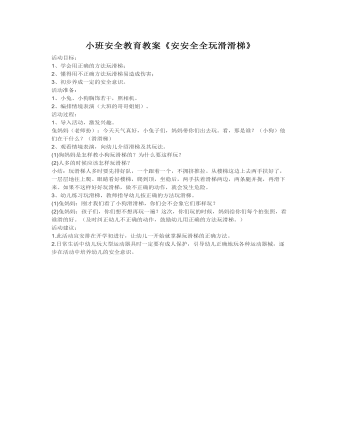
小班安全教育教案《安安全全玩滑滑梯》
2、懂得用不正确方法玩滑梯易造成伤害; 3、初步养成一定的安全意识。 活动准备: 1、小兔、小狗胸饰若干,照相机。 2、编排情境表演(大班的哥哥姐姐)。 活动过程: 1、导入活动,激发兴趣。 兔妈妈(老师扮):今天天气真好,小兔子们,妈妈带你们出去玩。看,那是谁?(小狗)他们在干什么?(滑滑梯) 2、观看情境表演,向幼儿介绍滑梯及其玩法。 (1)狗妈妈是怎样教小狗玩滑梯的?为什么要这样玩? (
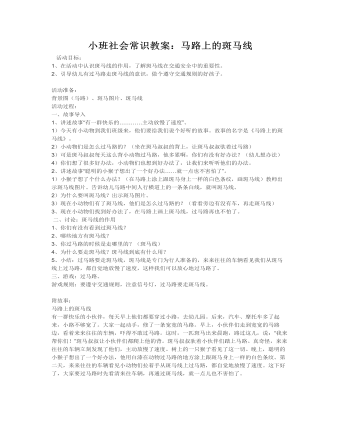
小班社会常识教案:马路上的斑马线
活动准备: 背景图(马路)、斑马图片、斑马线 活动过程: 一、故事导入 1、讲述故事“有一群快乐的…………主动放慢了速度”。 1)今天有小动物到我们班级来,他们要给我们说个好听的故事。故事的名字是《马路上的斑马线》。 2)小动物们是怎么过马路的?(坐在斑马叔叔的背上,让斑马叔叔驮着过马路) 3)可是斑马叔叔每天这么背小动物过马路,他多累啊,你们有没有好办法?(幼儿想办法) 4)你们想了很多好办法,小动物们也想到好办法了,让我们来听听他们的办法。 2、讲述故事“聪明的小猴子想出了一个好办法……就一点也不害怕了”。
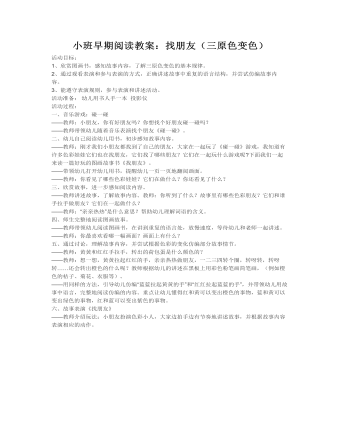
小班早期阅读教案:找朋友(三原色变色)
2、通过观看表演和参与表演的方式,正确讲述故事中重复的语言结构,并尝试仿编故事内容。 3、能遵守表演规则,参与表演和讲述活动。 活动准备: 幼儿用书人手一本 投影仪 活动过程: 一、音乐游戏:碰一碰 ——教师:小朋友,你有好朋友吗?你想找个好朋友碰一碰吗? ——教师带领幼儿随着音乐表演找个朋友《碰一碰》。 二、幼儿自己阅读幼儿用书,初步感知故事内容。 ——教师:刚才我们小朋友都找到了自己的朋友,大家在一起玩了《碰一碰》游戏,我知道有许多色彩娃娃它们也在找朋友,它们找了哪些朋友?它们在一起玩什么游戏呢?下面我们一起来读一篇好玩的图画故事书《找朋友》。 ——带领幼儿打开幼儿用书,提醒幼儿一页一页地翻阅画面。 ——教师:你看见了哪些色彩娃娃?它们在做什么?你还看见了什么?

大班健康综合活动教案:禁烟小卫士
一、目标1、知道新鲜空气对人们的重要性,了解抽烟对人体健康,社会环境的危害。2、增强幼儿关心、保护环境的意识,激发幼儿争做环保小卫士。二、准备:1、经验准备:幼儿了解吸烟对人体健康的危害。2、材料准备:教师:棉花、香烟、瓶子;幼儿:大型积木,剪刀,纸,食品包装,记号笔,禁烟标志等。三、过程:
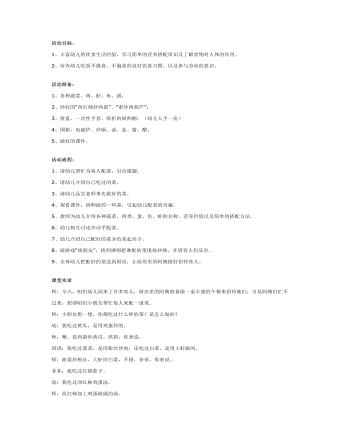
幼儿园大班健康教案:我是厨房小帮手
活动准备: 1、各种蔬菜、肉、虾、鱼、蛋; 2、炒好的“西红柿炒鸡蛋”、“素炒西葫芦”; 3、拼盘、一次性手套、纸折的厨师帽;(幼儿人手一份) 4、围裙、电磁炉、炒锅、油、盐、酱、醋。 5、做好的课件。 活动流程: 1、请幼儿帮忙为客人配菜,引出课题。 2、请幼儿介绍自己吃过的菜。 3、请幼儿品尝老师事先做好的菜。 4、观看课件:厨师做的一些菜,引起幼儿配菜的兴趣。 5、教师为幼儿介绍各种蔬菜、肉类、蛋、鱼、虾的名称、营养价值以及简单的搭配方法。 6、幼儿相互讨论并动手配菜。 7、幼儿介绍自己配好的菜并给菜起名字。 8、做游戏“找朋友”,找到谁则把谁配的菜现场炒熟,并请客人们品尝。 9、全体幼儿把配好的菜送到厨房,让厨房里的阿姨做好招待客人。
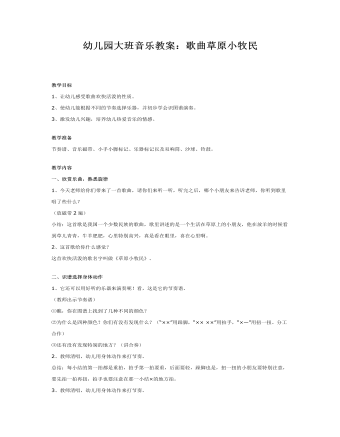
幼儿园大班音乐教案:歌曲草原小牧民
教学准备 节奏谱、音乐磁带、小手小脚标记、乐器标记以及双响筒、沙球、铃鼓。教学内容一、欣赏乐曲,熟悉旋律 1、今天老师给你们带来了一首歌曲,请你们来听一听,听完之后,哪个小朋友来告诉老师,你听到歌里唱了些什么? (放磁带2遍) 小结:这首歌是我国一个少数民族的歌曲,歌里讲述的是一个生活在草原上的小朋友,他在放羊的时候看到草儿青青,牛羊肥肥,心里特别高兴,真是看在眼里,喜在心里啊。 2、这首歌给你什么感觉? 这首欢快活泼的歌名字叫做《草原小牧民》。二、识谱选择身体动作 1、它还可以用好听的乐器来演奏呢!看,这是它的节奏谱。 (教师出示节奏谱) ⑴瞧,你在图谱上找到了几种不同的颜色? ⑵为什么是四种颜色?你们有没有发现什么?(“××”用跺脚,“×× ××”用拍手,“×—”用扭一扭。分工合作)
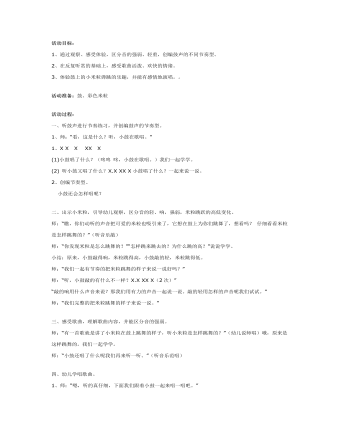
幼儿园大班音乐教案:跳舞的小米粒
活动准备:鼓、彩色米粒活动过程: 一、听鼓声进行节奏练习,并创编鼓声的节奏型。 1、师:“看,这是什么?听,小鼓在歌唱。” 1、X X X XX X (1)小鼓唱了什么?(咚咚咚,小鼓在歌唱。)我们一起学学。 (2) 听小鼓又唱了什么?X.X XX X小鼓唱了什么?一起来说一说。 2、创编节奏型。 小鼓还会怎样唱呢?二、出示小米粒,引导幼儿观察,区分音的轻、响,强弱,米粒跳跃的高低变化。 师:“瞧,你们动听的声音把可爱的米粒也吸引来了,它想在鼓上为你们跳舞了,想看吗?仔细看看米粒是怎样跳舞的?”(听音乐敲) 师:“你发现米粒是怎么跳舞的?”“怎样跳来跳去的?为什么跳的高?”说说学学。 小结:原来,小鼓敲得响,米粒跳得高,小鼓敲的轻,米粒跳得低。 师:“我们一起有节奏的把米粒跳舞的样子来说一说好吗?” 师:“听,小鼓敲的有什么不一样?X.X XX X(2次)” “敲的响用什么声音来说?那我们用有力的声音一起说一说。敲的轻用怎样的声音呢我们试试。” 师:“我们完整的把米粒跳舞的样子来说一说。”